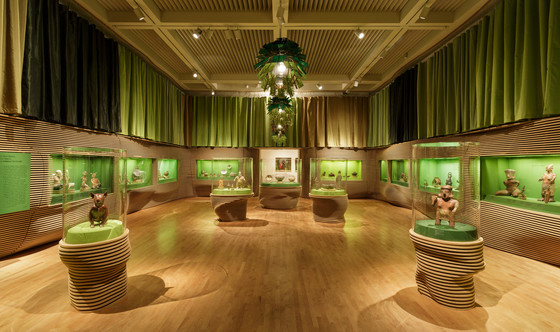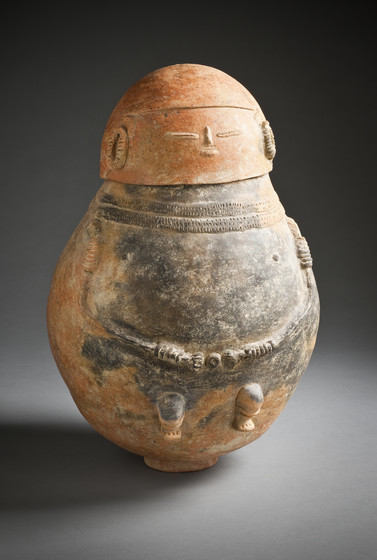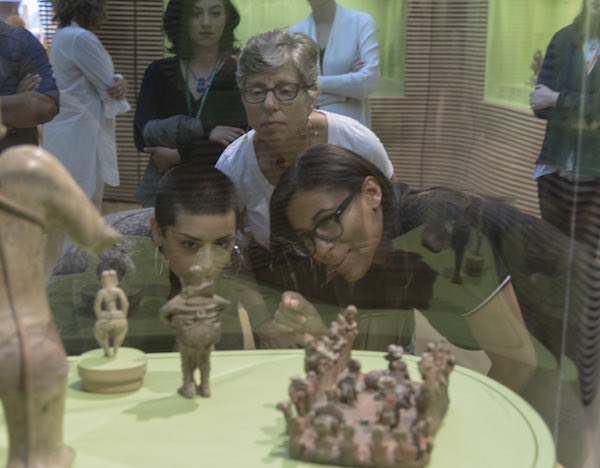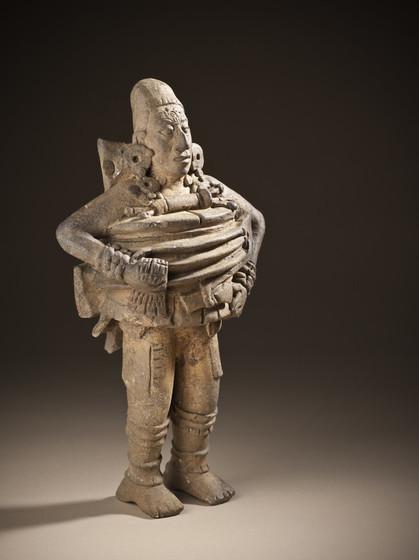During my first summer as an Andrew W. Mellon Undergraduate Curatorial Fellow at LACMA, where I am being mentored in the Art of the Ancient Americas department, I have developed a tour of a select group of objects on view in the permanent collection galleries that is based around a theme of my choosing, to present to my mentors, colleagues, and peers. This particular tour was inspired by my observations of LACMA’s visitors and some of the pieces that I found myself drawn to the most in the Art of the Ancient Americas collection. For this installment of Unframed, I’ll focus on one specific object to highlight the tour’s theme: body modification and adornment.

There is a small Maya figurine that is only about eight inches tall in the last room of our galleries in the Art of the Americas Building, Level 4. It’s hard to notice the object in a room containing larger, evocative warrior statues; intricate bowls from the Mimbres culture; and detailed sculptural scenes of religious rites and ballgame matches. However, if you lean down to inspect the figurine you will see a strong and noble ballplayer. This ancient ballplayer from Guatemala wears an elaborate outfit with thick bundles of cloth wrapped around his torso, heavy mitts, beaded bracelets, and a pair of large ear-flares that overlap with a necklace that goes across his chest. My favorite detail on this figure is the complex, curving tattoo or cicatrization (man-made scars as a form of adornment) that stretches across his forehead. This design and others like it in the collection (the result of purposeful and sometimes sacred body modifications) remind me of the varied tattoo designs I see on the people around me today.
.jpg)
When I want to take a break from my fellowship activities, or just need a cup of coffee in the afternoon, I like to sit on the L.A. Times Central Court between the Ahmanson Building and the Hammer Building to watch people enjoying their day at the museum. Some of the visitors I see inspire me with the ways they choose to dress themselves, how they wear their hair, or with the ways that they adorn themselves with piercings and tattoos. I personally do not have any tattoos or piercings (because I have a completely irrational fear of needles), but I admire how these decisions reflect each person on an individual level. People tend to get tattoos that remind them of their friends, family, and important events in their life—even tattoos that are abstract or seem meaningless often hold emotional weight.

This is a new form of sacred for the 21st century, one that is focused more on our personal lives and experiences than a more standardized practice and iconography. In our modern world it’s a powerful form of self-expression that we combine with things like the way we dress and wear our hair to assert our identities. It is fascinating to see how, in our society, we think of the way we construct our appearance as being unique and individualistic, while in the Maya world, appearance and adornment were tied less to the individual and more to history, cultural status, and religion. For example, we know from a 16th-century Spanish account that young Maya men were not allowed to tattoo themselves until after marriage when it was done as a marker of age and marital status.
Instead of connoting the ballplayer’s individual history or personality, the ballplayer’s facial design, clothes, and accessories all combine to convey culturally specific meanings. The ballplayer is not just a figure of sport and entertainment. His costume and the cranial elongation of his head show that he is a figure of high status, and his youthful face and costume make him a representation of an important moment in Maya cosmology. In the K’iche’ Maya Popol Vuh, a collection of cultural narratives of the K’iche’ people, the Hero Twins—two young Maya gods who defeated the lords of the Underworld in the ballgame but later were ultimately defeated by them—are ultimately reborn as the sun and the moon. While the ballgame was a feature of entertainment, it could also act as a religious performance where the ballplayers would use the game to re-enact the Hero Twins’ victory over death.
Understandably, the ball player and the contemporary museum visitor are displaced from each other by geography and by thousands of years. However, what I find fascinating are the connections between these two worlds—the power of the act of body modification and what it says about a person’s place in these societies. In both times and places, the process of body modification has a spiritual connection to the people who practice it: for the ancient Maya of Guatemala it had a very distinct religious and status-defining purpose, while in our modern era it can hold a more personal meaning in people's lives. One of the most fascinating things one can do while studying the art of the past is to find the ways it connects to the present.

This ballplayer is an ancient example of a star athlete, warrior, and religious actor. Contemplating his serene face, I wonder how the faces of the leaders and the heroes of our society will be interpreted in the future. In the patchwork of people I see visiting LACMA and in the ways I observe their decision to present themselves from head to toe, I find the same sense of beauty and nobility that I notice in the ballplayer. It is this idea of seeing different versions of ourselves in the past that I hope I was able to convey in my tour.



